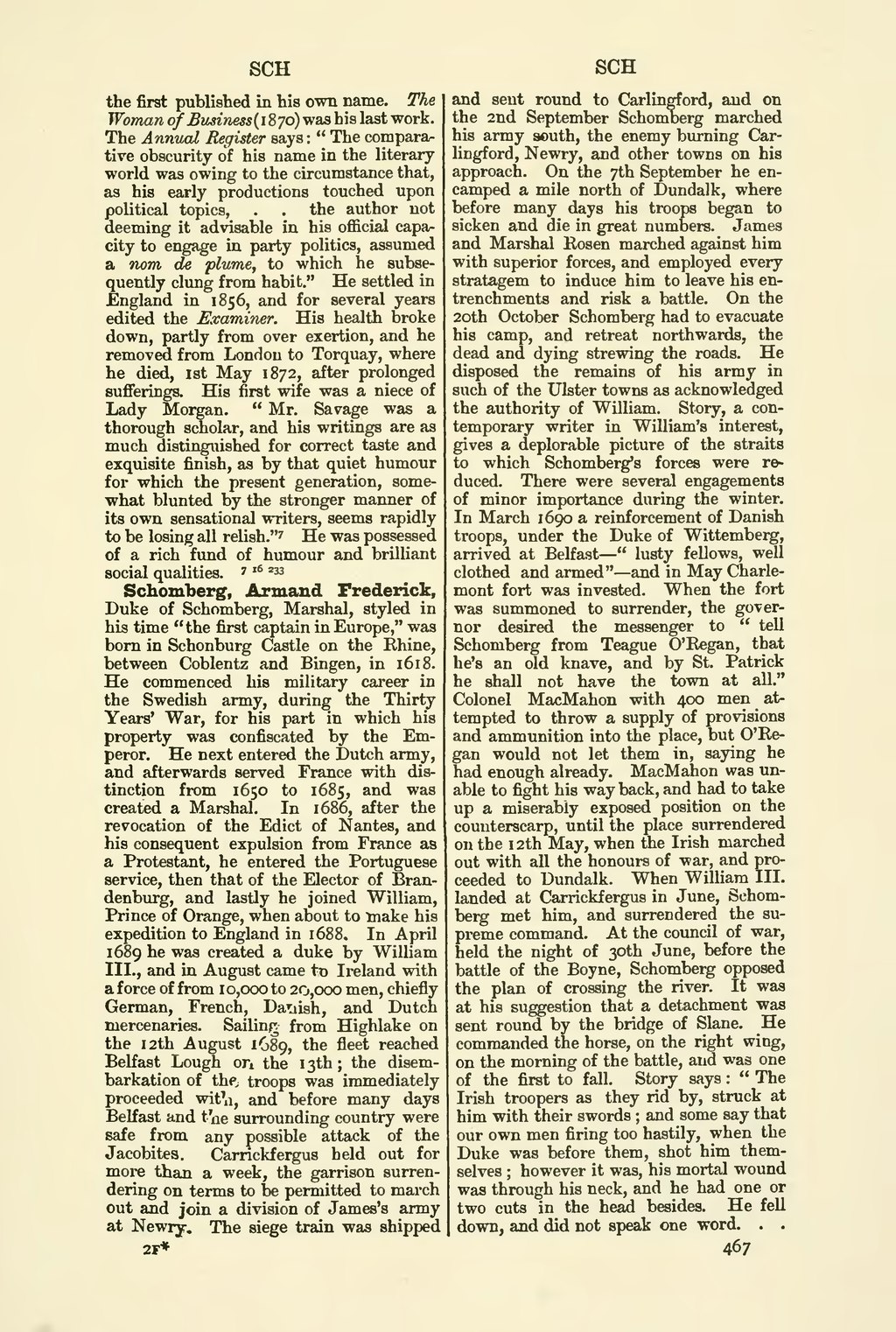SCH
the first published in his own name. The Woman of Bminess{i 8 70) was his last work. The Annual Register says : " The compara- tive obscurity of his name in the literary world was owing to the circumstance that, as his early productions touched upon political topics, . . the author not deeming it advdsable in his official capa- city to engage in party politics, assumed a tiom de plume, to which he subse- quently clung from habit," He settled in England in 1856, and for several years edited the Examiner. His health broke down, partly from over exertion, and he removed from London to Torquay, where he died, 1st May 1872, after prolonged sufferings. His first wife was a niece of Lady Morgan. " Mr. Savage was a thorough scholar, and his writings are as much distinguished for correct taste and exquisite finish, as by that quiet humour for which the present generation, some- what blunted by the stronger manner of its own sensational writers, seems rapidly to be losing all relish."' He was possessed of a rich fund of humour and brilliant social qualities. "> '* =^33
Schomberg, Armand Frederick, Duke of Schomberg, Marshal, styled in his time "the first captain in Europe," was bom in Schonburg Castle on the Ehine, between Coblentz and Bingen, in 161 8. He commenced his military cai^eer in the Swedish army, during the Thirty Years' War, for his part in which his property was confiscated by the Em- peror. He next entered the Dutch army, and afterwards served France with dis- tinction from 1650 to 1685, and was created a Marshal. In 1686, after the revocation of the Edict of Nantes, and his consequent expulsion from France as a Protestant, he entered the Portuguese service, then that of the Elector of Bran- denburg, and lastly he joined William, Prince of Orange, when about to make his expedition to England in 1688. In April 1689 he was created a duke by William III., and in August came to Ireland vdth a force of from 10,000 to 20,000 men, chiefly German, French, Datiish, and Dutch mercenaries. Sailinj^ from Highlake on the 12th August 1689, the fleet reached Belfast Lough ori the 13th; the disem- barkation of thf, troops was immediately proceeded wit'n, and before many days Belfast and t'ne surrounding country were safe from any possible attack of the Jacobites. Carrickfergus held out for more than a week, the garrison surren- dering on terms to be permitted to march out and join a division of James's army at Newry. The siege train was shipped
2F*
SCH
and sent round to Carlingford, and on the 2nd September Schomberg marched his army south, the enemy burning Car- lingford, Newry, and other towns on his approach. On the 7th September he en- camped a mile north of Dundalk, where before many days his troops began to sicken and die in great numbers. James and Marshal Bosen marched against him with superior forces, and employed every stratagem to induce him to leave his en- trenchments and risk a battle. On the 20th October Schomberg had to evacuate his camp, and retreat northwards, the dead and dying strewing the roads. He disposed the remains of his army in such of the Ulster towns as acknowledged the authority of William. Story, a con- temporary writer in William's interest, gives a deplorable picture of the straits to which Schomberg's forces were re- duced. There were several engagements of minor importance during the winter. In March 1690 a reinforcement of Danish ti'oops, under the Duke of Wittemberg, arrived at Belfast — " lusty fellows, well clothed and armed"— and in May Charle- mont fort was invested. When the fort was summoned to surrender, the gover- nor desired the messenger to " tell Schomberg from Teague O'Kegan, that he's an old knave, and by St. Patrick he shall not have the town at all." Colonel MacMahon with 400 men at- tempted to throw a supply of provisions and ammunition into the place, but O'Ke- gan would not let them in, saying he had enough already. MacMahon was un- able to fight his way back, and had to take up a miserably exposed position on the counterscarp, until the place surrendered on the 1 2th May, when the Irish marched out with all the honours of war, and pro- ceeded to Dundalk. When William III. landed at Carrickfergus in June, Schom- berg met him, and surrendered the su- preme command. At the council of war, held the night of 30th June, before the battle of the Boyne, Schomberg opposed the plan of crossing the river. It was at his suggestion that a detachment was sent round by the bridge of Slane. He commanded the horse, on the right wing, on the morning of the battle, and was one of the first to fall. Story says : " The Irish troopers as they rid by, struck at him with their swords ; and some say that our own men firing too hastily, when the Duke was before them, shot him them- selves ; however it was, his mortal wound was through his neck, and he had one or two cuts in the head besides. He fell down, and did not speak one word. . . 467
